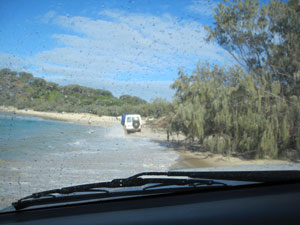Maybe the dingo ate your baby?
Add Summary

Blogger: Abigail Lynch, a doctoral candidate in the Department of Fisheries and Wildlife and a CSIS member, blogs from Down Under -- she's in Australia to build a framework for her dissertation research. She's interested in developing a decision-support tool to regulate harvest management strategies for lake whitefish in a changing climate.
Maybe the dingo ate your baby?
July 13, 2011
 Fraser Island is a world heritage site and the largest sand island in the world. Because of the quality of this sand, it was mined like some of the locations in the Great Lakes. If you’re not a geologist, or a sand miner, Fraser Island may be more famous because of its infamous inhabitants, dingos. Among the last “pure” dingo populations in eastern Australia, the Fraser Island dogs a becoming rarer but still have been known to have run-ins with campers and other tourists and we were lucky enough to meet one on the beach! We had a great two day trip driving a “ute” (utility vehicle) to all the sights including: Lake Wabby, Lake McKenzie, Central Station, the Wreck of the Maheno, Indian Head, Eli Creek and the Champagne Pools (where we could see humpback whales breaching and pirouetting near shore!). Driving was surely part of the adventure…traction (or lack there of) almost like driving in
Fraser Island is a world heritage site and the largest sand island in the world. Because of the quality of this sand, it was mined like some of the locations in the Great Lakes. If you’re not a geologist, or a sand miner, Fraser Island may be more famous because of its infamous inhabitants, dingos. Among the last “pure” dingo populations in eastern Australia, the Fraser Island dogs a becoming rarer but still have been known to have run-ins with campers and other tourists and we were lucky enough to meet one on the beach! We had a great two day trip driving a “ute” (utility vehicle) to all the sights including: Lake Wabby, Lake McKenzie, Central Station, the Wreck of the Maheno, Indian Head, Eli Creek and the Champagne Pools (where we could see humpback whales breaching and pirouetting near shore!). Driving was surely part of the adventure…traction (or lack there of) almost like driving in  snow.
snow.
Lynch's studies are supported by a William W. and Evelyn M. Taylor Endowed Fellowship for International Engagement in Coupled Human and Natural Systems, an International Studies and Programs Predissertation Award, an Ecology, Evolutionary Biology, and Behavior Summer Fellowship, a Graduate School Research Enhancement Award, and a travel award from the College of Agriculture and Natural Resources.



 Print
Print Email
Email





